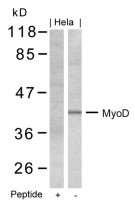ARG51115
anti-MyoD antibody
anti-MyoD antibody for Western blot and Human,Mouse,Rat
Developmental Biology antibody; Gene Regulation antibody
Overview
| Product Description | Rabbit Polyclonal antibody recognizes MyoD |
|---|---|
| Tested Reactivity | Hu, Ms, Rat |
| Tested Application | WB |
| Host | Rabbit |
| Clonality | Polyclonal |
| Isotype | IgG |
| Target Name | MyoD |
| Antigen Species | Human |
| Immunogen | Peptide sequence around aa.198~202 (A-S-S-P-R) derived from Human MyoD. |
| Conjugation | Un-conjugated |
| Alternate Names | PUM; MYF3; Myoblast determination protein 1; bHLHc1; Myogenic factor 3; MYOD; Myf-3; Class C basic helix-loop-helix protein 1 |
Application Instructions
| Application Suggestion |
|
||||
|---|---|---|---|---|---|
| Application Note | * The dilutions indicate recommended starting dilutions and the optimal dilutions or concentrations should be determined by the scientist. |
Properties
| Form | Liquid |
|---|---|
| Purification | Antibodies were produced by immunizing rabbits with KLH-conjugated synthetic peptide. Antibodies were purified by affinity-chromatography using epitope-specific peptide. |
| Buffer | PBS (without Mg2+ and Ca2+, pH 7.4), 150mM NaCl, 0.02% Sodium azide and 50% Glycerol. |
| Preservative | 0.02% Sodium azide |
| Stabilizer | 50% Glycerol |
| Concentration | 1 mg/ml |
| Storage Instruction | For continuous use, store undiluted antibody at 2-8°C for up to a week. For long-term storage, aliquot and store at -20°C. Storage in frost free freezers is not recommended. Avoid repeated freeze/thaw cycles. Suggest spin the vial prior to opening. The antibody solution should be gently mixed before use. |
| Note | For laboratory research only, not for drug, diagnostic or other use. |
Bioinformation
| Database Links | |
|---|---|
| Gene Symbol | MYOD1 |
| Gene Full Name | myogenic differentiation 1 |
| Background | MyoD encodes a nuclear protein that belongs to the basic helix-loop-helix family of transcription factors and the myogenic factors subfamily. It regulates muscle cell differentiation by inducing cell cycle arrest, a prerequisite for myogenic initiation. The protein is also involved in muscle regeneration. It activates its own transcription which may stabilize commitment to myogenesis. |
| Function | Acts as a transcriptional activator that promotes transcription of muscle-specific target genes and plays a role in muscle differentiation. Together with MYF5 and MYOG, co-occupies muscle-specific gene promoter core region during myogenesis. Induces fibroblasts to differentiate into myoblasts. Interacts with and is inhibited by the twist protein. This interaction probably involves the basic domains of both proteins (By similarity). [UniProt] |
| Research Area | Developmental Biology antibody; Gene Regulation antibody |
| Calculated MW | 35 kDa |
| PTM | Phosphorylated by CDK9. This phosphorylation promotes its function in muscle differentiation. Acetylated by a complex containing EP300 and PCAF. The acetylation is essential to activate target genes. Conversely, its deacetylation by SIRT1 inhibits its function (By similarity). Ubiquitinated on the N-terminus; which is required for proteasomal degradation. Methylation at Lys-104 by EHMT2/G9a inhibits myogenic activity. |
Images (1) Click the Picture to Zoom In






